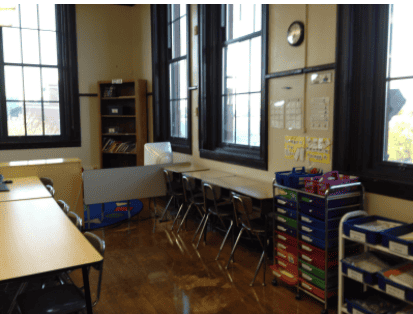5 Tips for Optimizing Classroom Setup for Students with ADHD and Autism Spectrum Disorder (ASD)

|
Getting your Trinity Audio player ready...
|
Creating an Optimal Learning Environment for Students with ADHD and Autism Spectrum Disorder
The environmental set-up can impact a student’s ability to focus and follow directions. This can be true for students who are (and who are not) diagnosed with ADHD or Autism Spectrum Disorder.
In a group situation like a classroom, it can be extremely difficult for an educator to modify every part of the environment to meet every need.
However, it is helpful for those educating our students to have knowledge of some common strategies that have been shown to make a positive difference for students with ADHD or those on the spectrum.
Related Article: 15 Behavior Strategies for Children on the Autism Spectrum
A distraction-free and structured/predictable environment is most conducive to learning and behavior for kids who:
- Become distracted easily
- Get overwhelmed by too much input
- Have visual-perceptual challenges (e.g., may have trouble visualizing where they are supposed to sit, where their area is in the room is, how to get from point A to point B)
- Have trouble understanding what is expected when given verbal directions (such as those with difficulty processing language)
5 Tips for Maintaining a Distraction-Free and Organized Classroom
Again, since every individual is different, every strategy will not work with every child. You may need to try different strategies to see what works best for your child.
1. Keep Materials Out of View When Not in Use
- Reduce clutter by having a designated place for things (e.g., toys in a bin, papers and pens in a drawer, etc.).
- During important tasks like dinner or homework/classwork, move distracting materials out of sight or keep them in closed containers.
- If you use containers on shelves (common in classrooms), consider hanging a cloth over the shelves to conceal them, preventing your child from being distracted by the actual bins (e.g., wanting to access them or take materials out).
- Establish a structured schedule that informs students when they will use specific materials and provides clear directions for accessing materials from the bins.
- For students who have difficulty reading or understanding verbal language, use a combination of words and pictures to indicate what is stored in the bins. This visual support helps students identify where to find the items they need and where to put them away. See an example in the image below.


By implementing these strategies, you can effectively reduce visual distractions and create a conducive environment for focused learning and activities.
2. Minimize Wall Decorations and Artwork
Sometimes, children can become easily distracted by the multitude of artwork and decorations on the walls. This distraction isn’t limited to students diagnosed with Autism Spectrum or ADHD; it can affect any student.
To minimize distractions, consider centralizing artwork and decorations in one designated area, such as a bulletin board (positioned right outside the room or in a specific location within the room), rather than scattering them throughout the entire space.
The same principle applies to art materials, as seen in the bookshelf images above. While art and creations should be celebrated, they can be displayed in a manner that minimizes distractions. When artwork is spread across the room, it can result in some children being frequently drawn to the visual stimuli.
Here are a few examples of streamlined art displays:

3. Give the Classroom or Learning Space Clearly Defined Areas
Establish distinct zones within the classroom or learning space, especially in classrooms that have various stations like a reading area, seat-work area, computer area, play area, sensory area, and more.
Utilize methods such as tape, room dividers, colorful carpets (often available as donations from carpet stores), or bookshelves to delineate these designated areas.
For inspiration and visual examples, you can explore classrooms with clearly defined areas on autismtank.blogspot.com.


You can also see some examples on theautismhelper.com, such as the ones shown in the images below.

Students with specific needs often thrive in an environment where areas are clearly defined. This approach can be particularly helpful for students who experience:
- Sensitivity to Visual Distractions
- Overwhelm from Excessive Sensory Input
- Difficulty Understanding the Idea of Staying in One Place
- Challenges with Classroom Navigation
To support students in navigating the environment more effectively, consider incorporating visual aids, such as pictures and words, to label distinct areas. For instance, you can use labels like the following for different areas:
[Include an example label or visual representation to enhance the visual appeal]
By implementing this approach, you can create a learning space that caters to individual needs and promotes focused and effective learning for all students.

4. Implement a Schedule (Both Written and Visual)
A well-structured schedule provides students with a clear understanding of when they will utilize various areas and what activities are planned throughout the day.
As students transition between different activities, make sure to refer to the schedule to maintain a smooth flow.
Related Article: How to Use Schedules to Improve Student Behavior
By incorporating schedules, you can instill a sense of structure and predictability, ultimately enhancing the learning experience for your students.

Some students perform optimally with visual mini-schedules, such as completing a math puzzle before moving on to computer activities.
To provide students with a clear sense of progress and tasks ahead, you may opt for a customizable schedule approach. Here’s how:
- Consider dividing the schedule into distinct sections that can be easily removed.
- This enables children to visualize completed tasks and gain clarity on what remains to be accomplished.
One practical method to achieve this is by laminating the individual components of the schedule and attaching velcro to the back of each piece.
By doing so, you create a dynamic and interactive learning tool that fosters structure and engagement.
Related Article: How to Use Schedules to Improve Children’s Behavior
5. Create Dedicated Spaces for Effective Learning
Some students thrive when they have clearly defined spots for various activities, whether it’s working, playing, or eating. Visual cues can be immensely helpful.
As an example,, a child struggling to stay within their designated area in the classroom may find value in having tape on the floor, outlining their spot, and providing clear boundaries.
For a visual representation, take a look at the image below for practical examples:

Utilize visual cues and small area rugs to clearly define spaces within the classroom. This approach allows students to have designated areas for various activities.
For students who benefit from movement, provide flexible seating options that allow them to stand while working or have enough room to move around their desk or chair.
To create an inclusive atmosphere and ensure students’ needs are met without singling anyone out, consider defining each student’s area within the classroom. This approach simplifies communication by providing a clear reference point for guiding students to their designated spaces when necessary.
Another effective way to visually define a student’s space is by using cushions or mats when students are sitting on the floor during activities.

Help students establish their own designated spots within the classroom. This can be achieved using tape markings for visual cues. Tape is especially useful if there’s a concern that students might move or play with their mats or cushions.
Another option is using educational rugs, commonly used during storytime. These rugs often have letters, numbers, or squares that students can sit on, such as “Brian, sit on the letter A.”
For a visual example, here is an educational rug that uses squares to designate spots. These methods promote structure and active participation in the classroom.
In some cases, students can benefit greatly from having their workspace on their desk clearly defined. For instance, if your classroom is organized with students sitting at tables in groups of four, some children might require visual cues to help them understand their workspace boundaries.
One simple yet effective solution is to use tape to delineate each child’s individual workspace on the table. This provides them with a clear visual reference (as shown below) to help them stay organized and focused during tasks.

Certain students, especially those with visual perceptual and language processing difficulties, may struggle to understand or retain verbal directions like “keep your materials in your space.” For these students, visual definitions can make a difference.
This approach provides a clear and tangible reference point, making it easier for them to understand and follow instructions.
Additional Classroom Considerations for ADHD and ASD
While this article primarily focuses on visual organization and minimizing distractions, there are other valuable elements to consider when setting up a classroom for students with diverse needs.
Cozy Corner:
For instance, creating a cozy space or corner where students can relax and calm down can be immensely beneficial. This provides a safe haven for students to recharge and regain focus, as exemplified in the image below.

Establish a cozy corner equipped with books, a comfy blanket, calming objects, etc. This provides students with a cozy sanctuary within the classroom.
Remember, there are various ways to create a cozy corner, so tailor it to your classroom setup.
Movement-Friendly Section:
If your classroom allows, designate a section for movement. This area can accommodate items like stability balls, wobble seats (which some classrooms are adopting instead of traditional seats), hanging swings, or trampolines. It serves as a space for students who require frequent movement breaks throughout the day.
Sensory and Fidget Items:
Consider incorporating sensory and fidget items in the break area or allowing students to use them during learning time. However, it’s important to establish clear guidelines for the use of these items to prevent distractions.
Organization and Clarity:
Ensure that your break and calm-down spaces are clearly defined and separate from the main classroom area. This makes it easy for students to identify these spaces.
Tips for Parents to Optimize the Learning Environment at Home
Before creating a “distraction-free” environment at home, consider the following:
As a parent, it is easy to become stressed and overwhelmed, especially with all the other things we have going on in our lives such as work, cleaning the house, paying the bills, etc.
When you have a child with learning differences or behavioral challenges, it can be especially overwhelming because you may have frequent appointments with doctors, service providers (e.g., speech therapy, occupational therapy, physical therapy, mental-health counseling, behavior specialists), your child’s school, etc.
When you are juggling so many things at once, it can be very difficult to ensure that your house is always distraction-free and structured, so do the best you can. You cannot be expected to be perfect, and don’t get down on yourself if you don’t continually manage the suggestions in this article.
Additionally, some of these strategies are more practical for the classroom environment, so think about the ones that you think would work for you and your current situation.
References:
- Classroom Structuring Methods and Strategies for Children and Youth with Autism Spectrum Disorders
- Environmental Strategies for Managing Attention Deficit Hyperactivity Disorder
Education and Behavior – Keeping Us on the Same Page for Children!
4 thoughts on “5 Tips for Optimizing Classroom Setup for Students with ADHD and Autism Spectrum Disorder (ASD)”
Comments are closed.








Excellent recommendations!
I’ll include a link to this site on my website.
take care,
flip
Thank, Flip!
DecodingMyAutism.com is our website to try and help parents and children living with Autism in their lives. We are focused on delivering you the best book we can possible create. When you think of a sunny day and your child is happy, but their is always that thing you should mention. Or that little factoid that could make the difference between an awkward moment and a delightful experience. What do I truly need to know to take care of your child for an hour or two?
http://www.decodingmyautism.com/